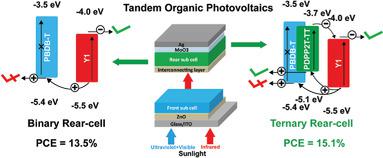当前位置:
X-MOL 学术
›
Adv. Mater.
›
论文详情
Our official English website, www.x-mol.net, welcomes your
feedback! (Note: you will need to create a separate account there.)
Enabling High-Performance Tandem Organic Photovoltaic Cells by Balancing the Front and Rear Subcells.
Advanced Materials ( IF 27.4 ) Pub Date : 2020-08-16 , DOI: 10.1002/adma.202002315 Pei Cheng,Hao-Cheng Wang,Ran Zheng,Yuan Zhu,Shuixing Dai,Zeyuan Li,Chung-Hao Chen,Yepin Zhao,Rui Wang,Dong Meng,Chenhui Zhu,Kung-Hwa Wei,Xiaowei Zhan,Yang Yang
Advanced Materials ( IF 27.4 ) Pub Date : 2020-08-16 , DOI: 10.1002/adma.202002315 Pei Cheng,Hao-Cheng Wang,Ran Zheng,Yuan Zhu,Shuixing Dai,Zeyuan Li,Chung-Hao Chen,Yepin Zhao,Rui Wang,Dong Meng,Chenhui Zhu,Kung-Hwa Wei,Xiaowei Zhan,Yang Yang

|
In tandem organic photovoltaics, the front subcell is based on large‐bandgap materials, whereas the case of the rear subcell is more complicated. The rear subcell is generally composed of a narrow‐bandgap acceptor for infrared absorption but a large‐bandgap donor to realize a high open‐circuit voltage. Unfortunately, most of the ultraviolet–visible part of the photons are absorbed by the front subcell; as a result, in the rear subcell, the number of excitons generated on large‐bandgap donors will be reduced significantly. This reduces the (photo) conductivity and finally limits the hole‐transporting property of the rear subcell. In this work, a simple and effective way is proposed to resolve this critical issue. To ensure sufficient photogenerated holes in the rear subcell, a small amount of an infrared‐absorbing polymer donor as a third component is introduced, which provides a second hole‐generation and transporting mechanism to minimize the aforementioned detrimental effects. Finally, the short‐circuit current density of the two‐terminal tandem organic photovoltaic is significantly enhanced from 10.3 to 11.7 mA cm−2 (while retaining the open‐circuit voltage and fill factor) to result in an enhanced power conversion efficiency of 15.1%.
中文翻译:

通过平衡前后子电池来启用高性能串联有机光伏电池。
在串联有机光伏中,前子电池是基于大带隙材料的,而后子电池的情况则更为复杂。后部子电池通常由一个窄带隙受体用于红外吸收而由一个大带隙施主组成,以实现高开路电压。不幸的是,光子的大部分紫外线可见部分都被前子细胞吸收了。结果,在后部子电池中,大带隙供体上产生的激子数量将大大减少。这降低了(光电)电导率,并最终限制了后子电池的空穴传输性能。在这项工作中,提出了一种简单有效的方法来解决此关键问题。为了确保后子电池中有足够的光生空穴,引入了少量的红外吸收聚合物供体作为第三种成分,它提供了第二种空穴生成和传输机制,可最大程度地减少上述有害影响。最后,两端串联有机光伏电池的短路电流密度从10.3 mA显着提高到11.7 mA cm−2(同时保留开路电压和填充因数)可提高15.1%的功率转换效率。
更新日期:2020-09-21
中文翻译:

通过平衡前后子电池来启用高性能串联有机光伏电池。
在串联有机光伏中,前子电池是基于大带隙材料的,而后子电池的情况则更为复杂。后部子电池通常由一个窄带隙受体用于红外吸收而由一个大带隙施主组成,以实现高开路电压。不幸的是,光子的大部分紫外线可见部分都被前子细胞吸收了。结果,在后部子电池中,大带隙供体上产生的激子数量将大大减少。这降低了(光电)电导率,并最终限制了后子电池的空穴传输性能。在这项工作中,提出了一种简单有效的方法来解决此关键问题。为了确保后子电池中有足够的光生空穴,引入了少量的红外吸收聚合物供体作为第三种成分,它提供了第二种空穴生成和传输机制,可最大程度地减少上述有害影响。最后,两端串联有机光伏电池的短路电流密度从10.3 mA显着提高到11.7 mA cm−2(同时保留开路电压和填充因数)可提高15.1%的功率转换效率。











































 京公网安备 11010802027423号
京公网安备 11010802027423号